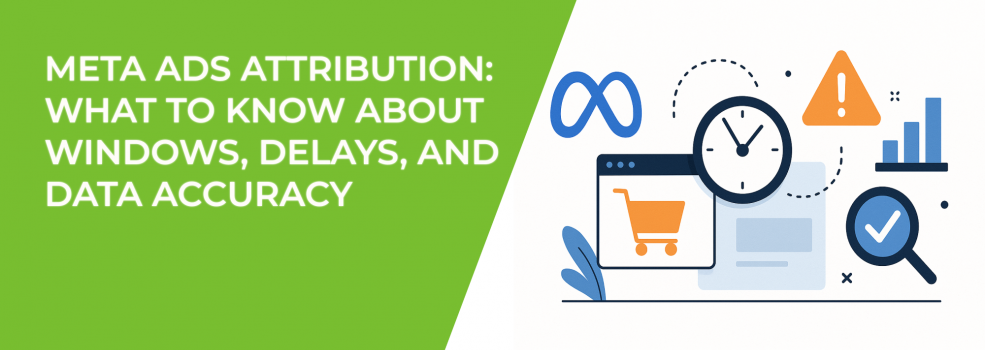Meta Ads attribution is the invisible thread connecting your ad spend to your results. It determines which ad gets credit for a conversion and — more importantly — how you see performance in Meta Ads Manager. Get it wrong, and you could be optimizing for the wrong thing. Get it right, and you’ll have clarity that can transform your ad strategy.
But here’s the catch: attribution isn’t just a reporting tool. It directly influences who sees your ads and how Meta optimizes delivery.
Let’s break it down.
What Meta Ads Attribution Really Means
When someone interacts with your ad on Facebook, Instagram, or the Audience Network, they can take actions either on your ad or off your ad.
-
On-ad actions: Things like watching a video, clicking a link, reacting, or sharing.
-
Off-ad actions: Purchases, sign-ups, or other events on your website or app after engaging with your ad.
-
Both on and off: For example, RSVPing to an event on the ad itself or after visiting the event page.
Meta tracks these actions and credits them back to your ad — but only if they happen within a specific attribution window.
Understanding Attribution Windows
An attribution window is the time frame Meta uses to decide whether an action is tied to your ad. The default setting is 7-day click and 1-day view.
That means:
-
If someone clicks your ad and converts within 7 days, the conversion counts.
-
If someone sees (but doesn’t click) your ad and converts within 1 day, the conversion counts.
You can customize these windows at the ad set level:
-
Click-through: 1-day or 7-day.
-
View-through: 1-day or none.
-
Engaged view (video ads): 1-day or none (must match view-through setting).
The choice you make here impacts both reporting and delivery optimization. Shorter windows can give you cleaner, more immediate data. Longer windows can capture delayed decision-making — but might also inflate your numbers.
For a deeper breakdown of how different conversion windows work and how they influence campaign reporting, check out our full guide on understanding the conversion window in Facebook Ads.
How Delays Affect Your Data
Even when attribution is set, there can be reporting delays. Purchases, especially from mobile users or in markets with slower payment processing, may take hours or even days to appear.
This is normal. Meta needs to verify the event, match it to the ad, and apply the right window setting.
Pro tip: If you’re comparing results day-to-day, don’t rush to judge performance within the first 24 hours. Yesterday’s numbers may look different tomorrow.
Balancing Accuracy and Attribution
Choosing the right attribution setting is about balancing data accuracy and campaign goals.
-
Selling a high-ticket item that requires consideration? A 7-day click window makes sense.
-
Promoting a free trial or webinar with quick sign-ups? A 1-day click window will give you faster, cleaner feedback.
-
Running remarketing ads to warm audiences? You might want to turn off 1-day view to avoid over-counting.
The goal is to avoid misleading metrics that cause you to spend more on ads that aren’t really driving results.
Attribution data is only part of the picture — understanding the full story requires looking at deeper performance metrics, as we cover in how to analyze Facebook ad performance beyond CTR and CPC.
Comparing Attribution Settings in Meta Ads Manager
If you’re unsure which setting is best, you can compare windows directly in Ads Manager:
-
Go to the Columns dropdown and choose Compare Attribution Settings.
-
Select multiple windows (e.g., 1-day click, 7-day click, 1-day view).
-
See how your conversions shift across different models.
This gives you a clearer view of how quickly your audience acts — and whether view-through conversions are skewing your results.
Meta’s attribution tool can help you see which touchpoints truly drive results — here’s a step-by-step on how to use Facebook’s Attribution Tool to refine your ad strategies.
Key Takeaways
Meta Ads attribution does more than track results — it actively influences ad delivery. Keep these points in mind:
-
It’s not just reporting — your attribution setting affects who sees your ads and how Meta optimizes them.
-
Shorter windows mean faster, more precise feedback, but fewer reported conversions.
-
Longer windows capture delayed actions, but may overstate performance.
-
Reporting delays are normal — wait before judging same-day results.
-
Always compare windows before making big budget decisions.
When you know how attribution works, you stop relying on guesswork. You make confident, data-driven calls — and in today’s privacy-first ad environment, that’s a real competitive advantage.

